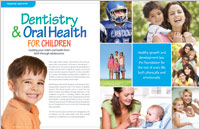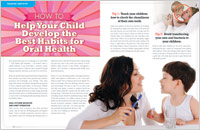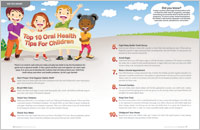Children do not keep their first teeth forever, but that doesn’t mean their tiny pearly white teeth don’t need to be cared for. Keeping up with the dental health of your child now will help give health benefits into adulthood, as primary - baby - teeth their function is critical.
 For one, primary teeth serve as guides for the entrance of permanent - adult - teeth, creating a space where these new teeth will enter. The crowns - tops - of the permanent teeth enter pushing against the roots of baby teeth, causing them to melt away. In this way, adult teeth take their proper place.
What’s even more important is your child’s primary teeth will be there for most of childhood, helping your child to chew, bite and speak. For the first six years or so, your child will rely on their primary teeth sole to perform these essential functions. Until about the age of 12, your child will start to have a mix of primary and permanent teeth. Your job now will be to make sure those teeth stay healthy and are lost naturally — until its time.
For one, primary teeth serve as guides for the entrance of permanent - adult - teeth, creating a space where these new teeth will enter. The crowns - tops - of the permanent teeth enter pushing against the roots of baby teeth, causing them to melt away. In this way, adult teeth take their proper place.
What’s even more important is your child’s primary teeth will be there for most of childhood, helping your child to chew, bite and speak. For the first six years or so, your child will rely on their primary teeth sole to perform these essential functions. Until about the age of 12, your child will start to have a mix of primary and permanent teeth. Your job now will be to make sure those teeth stay healthy and are lost naturally — until its time.
 Your child will have 20 baby teeth that will begin to start appearing usually between 6 to 9 months, though in some cases you may start to see them from the age of 3 months or as late as 12 months. The two lower front teeth tend to erupt first, followed by the two upper ones. The molars come in next, then by the canines (eyeteeth). Sometimes teething discomfort may be felt by your child during this process. If so, there are different courses of action that you can take to help make your child more comfortable.
The gums of your infant and newly erupted teeth should be wiped gently after each feeding with a damp washcloth or water-slacked gauze pad. Beginning at age 2, when there are more teeth in the mouth, start a daily teeth brushing routine with a small, soft-bristled toothbrush and just a smear of fluoride toothpaste. Your child may need your help until about the age of 6 with this very critical task.
Your child will have 20 baby teeth that will begin to start appearing usually between 6 to 9 months, though in some cases you may start to see them from the age of 3 months or as late as 12 months. The two lower front teeth tend to erupt first, followed by the two upper ones. The molars come in next, then by the canines (eyeteeth). Sometimes teething discomfort may be felt by your child during this process. If so, there are different courses of action that you can take to help make your child more comfortable.
The gums of your infant and newly erupted teeth should be wiped gently after each feeding with a damp washcloth or water-slacked gauze pad. Beginning at age 2, when there are more teeth in the mouth, start a daily teeth brushing routine with a small, soft-bristled toothbrush and just a smear of fluoride toothpaste. Your child may need your help until about the age of 6 with this very critical task.
 The American Academy of Pediatric Dentistry recommends that your child see a pediatric dentistry their fist birthday. This may sound too early, but learning proper pediatric oral hygiene techniques, checking for cavities, and checking for any developmental problems is extremely important.
There are various forms of tooth decay that can affect small children and babies. Early Childhood Caries (tooth decay) can develop very rapidly, starting at the hard, outer enamel layer of a tooth reaching into the softer, inner dentin in six months or less time.
It’s more important, as well, for your child to experience going to a Guelph Pediatric Dentist in a positive way as this will help your child become a regular visitor for years to come.
The American Academy of Pediatric Dentistry recommends that your child see a pediatric dentistry their fist birthday. This may sound too early, but learning proper pediatric oral hygiene techniques, checking for cavities, and checking for any developmental problems is extremely important.
There are various forms of tooth decay that can affect small children and babies. Early Childhood Caries (tooth decay) can develop very rapidly, starting at the hard, outer enamel layer of a tooth reaching into the softer, inner dentin in six months or less time.
It’s more important, as well, for your child to experience going to a Guelph Pediatric Dentist in a positive way as this will help your child become a regular visitor for years to come.
 Somewhere around the age of 7, most malocclusions are evident. Interceptive orthodontic treatment at this age can help to direct the teeth to their proper positioning and/or jaw growth, simplifying or eliminating the need for later treatment. There are a variety of orthodontic problems that can be detected early and are examples of why a trained profession, like a pediatric dentist, should evaluate your child throughout their growth and development.
Somewhere around the age of 7, most malocclusions are evident. Interceptive orthodontic treatment at this age can help to direct the teeth to their proper positioning and/or jaw growth, simplifying or eliminating the need for later treatment. There are a variety of orthodontic problems that can be detected early and are examples of why a trained profession, like a pediatric dentist, should evaluate your child throughout their growth and development.
 Dentistry and Oral Health for Children Dear Doctor magazine brings you this wide-ranging overview of milestones and transitions in your child's dental development. Learn how to protect your children from tooth decay, dental injuries, and unhealthy habits while getting them started on the road to a lifetime of oral health and general well-being... Read Article
Dentistry and Oral Health for Children Dear Doctor magazine brings you this wide-ranging overview of milestones and transitions in your child's dental development. Learn how to protect your children from tooth decay, dental injuries, and unhealthy habits while getting them started on the road to a lifetime of oral health and general well-being... Read Article
 Pregnancy & Oral Health Pregnancy is generally thought of as the time when a woman strives to be particularly aware of the need for better health. Many women, though, may not be aware of the link that exists between their oral health and their systemic (general) health, as well as the impact this can have on a developing child. Learn about how to care for yourself and your baby... Read Article
Pregnancy & Oral Health Pregnancy is generally thought of as the time when a woman strives to be particularly aware of the need for better health. Many women, though, may not be aware of the link that exists between their oral health and their systemic (general) health, as well as the impact this can have on a developing child. Learn about how to care for yourself and your baby... Read Article
 How to Help Your Child Develop the Best Habits for Oral Health Proper oral health habits are easy to learn — and lead to behaviors that result in lifelong dental health. And the time to begin is as soon as your child's first baby teeth appear. From toothbrushing for your toddler to helping your teenager stay away from tobacco, Dear Doctor magazine offers the most important tips for healthy habit formation through childhood and beyond... Read Article
How to Help Your Child Develop the Best Habits for Oral Health Proper oral health habits are easy to learn — and lead to behaviors that result in lifelong dental health. And the time to begin is as soon as your child's first baby teeth appear. From toothbrushing for your toddler to helping your teenager stay away from tobacco, Dear Doctor magazine offers the most important tips for healthy habit formation through childhood and beyond... Read Article
 Top 10 Oral Health Tips for Children There's no need to wait until your baby actually has teeth to lay the foundations for good oral or general health. In fact, good nutrition and oral hygiene can start right away. It is up to you to develop the routines that will help protect your child from tooth decay and other oral health problems. So let's get started... Read Article
Top 10 Oral Health Tips for Children There's no need to wait until your baby actually has teeth to lay the foundations for good oral or general health. In fact, good nutrition and oral hygiene can start right away. It is up to you to develop the routines that will help protect your child from tooth decay and other oral health problems. So let's get started... Read Article
 For one, primary teeth serve as guides for the entrance of permanent - adult - teeth, creating a space where these new teeth will enter. The crowns - tops - of the permanent teeth enter pushing against the roots of baby teeth, causing them to melt away. In this way, adult teeth take their proper place.
What’s even more important is your child’s primary teeth will be there for most of childhood, helping your child to chew, bite and speak. For the first six years or so, your child will rely on their primary teeth sole to perform these essential functions. Until about the age of 12, your child will start to have a mix of primary and permanent teeth. Your job now will be to make sure those teeth stay healthy and are lost naturally — until its time.
For one, primary teeth serve as guides for the entrance of permanent - adult - teeth, creating a space where these new teeth will enter. The crowns - tops - of the permanent teeth enter pushing against the roots of baby teeth, causing them to melt away. In this way, adult teeth take their proper place.
What’s even more important is your child’s primary teeth will be there for most of childhood, helping your child to chew, bite and speak. For the first six years or so, your child will rely on their primary teeth sole to perform these essential functions. Until about the age of 12, your child will start to have a mix of primary and permanent teeth. Your job now will be to make sure those teeth stay healthy and are lost naturally — until its time.
Your Child’s First Teeth
 Your child will have 20 baby teeth that will begin to start appearing usually between 6 to 9 months, though in some cases you may start to see them from the age of 3 months or as late as 12 months. The two lower front teeth tend to erupt first, followed by the two upper ones. The molars come in next, then by the canines (eyeteeth). Sometimes teething discomfort may be felt by your child during this process. If so, there are different courses of action that you can take to help make your child more comfortable.
The gums of your infant and newly erupted teeth should be wiped gently after each feeding with a damp washcloth or water-slacked gauze pad. Beginning at age 2, when there are more teeth in the mouth, start a daily teeth brushing routine with a small, soft-bristled toothbrush and just a smear of fluoride toothpaste. Your child may need your help until about the age of 6 with this very critical task.
Your child will have 20 baby teeth that will begin to start appearing usually between 6 to 9 months, though in some cases you may start to see them from the age of 3 months or as late as 12 months. The two lower front teeth tend to erupt first, followed by the two upper ones. The molars come in next, then by the canines (eyeteeth). Sometimes teething discomfort may be felt by your child during this process. If so, there are different courses of action that you can take to help make your child more comfortable.
The gums of your infant and newly erupted teeth should be wiped gently after each feeding with a damp washcloth or water-slacked gauze pad. Beginning at age 2, when there are more teeth in the mouth, start a daily teeth brushing routine with a small, soft-bristled toothbrush and just a smear of fluoride toothpaste. Your child may need your help until about the age of 6 with this very critical task.
Your Child’s First Dental Appointment
 The American Academy of Pediatric Dentistry recommends that your child see a pediatric dentistry their fist birthday. This may sound too early, but learning proper pediatric oral hygiene techniques, checking for cavities, and checking for any developmental problems is extremely important.
There are various forms of tooth decay that can affect small children and babies. Early Childhood Caries (tooth decay) can develop very rapidly, starting at the hard, outer enamel layer of a tooth reaching into the softer, inner dentin in six months or less time.
It’s more important, as well, for your child to experience going to a Guelph Pediatric Dentist in a positive way as this will help your child become a regular visitor for years to come.
The American Academy of Pediatric Dentistry recommends that your child see a pediatric dentistry their fist birthday. This may sound too early, but learning proper pediatric oral hygiene techniques, checking for cavities, and checking for any developmental problems is extremely important.
There are various forms of tooth decay that can affect small children and babies. Early Childhood Caries (tooth decay) can develop very rapidly, starting at the hard, outer enamel layer of a tooth reaching into the softer, inner dentin in six months or less time.
It’s more important, as well, for your child to experience going to a Guelph Pediatric Dentist in a positive way as this will help your child become a regular visitor for years to come.
Pediatric Dental Treatments
There is an array of pediatric dental treatments offered to prevent children from having tooth decay, to save or repair their teeth when necessary. They can include: Topical Fluoride — Fluoride fuses into the enamel of teeth, making it difficult and resistant more to tooth decay. Even though there is a small amount of fluoride in toothpaste and some drinking water supplies, there can be a higher concentration applied professionally to your child’s teeth for maximum protection. Dental Sealants — A coating made of plastic can be implemented at a pediatric dental office for prevention of cavities by sealing the grooves on back teeth, molars that are used for chewing, known as “fissures and pits”. These little spaces become the perfect environments for tooth decay-causing bacteria. Adolescent tooth enamel is more absorbent and, therefore, less resistant to tooth decay. Pediatric Dental sealants can easily be applied and help to provide years of added protection. Click here to watch Dental Sealant Video. Root Canal Treatment — Maybe you have had a root canal treatment yourself, to save or prevent tooth decay. Well, there are instances when children need root canals, too. In the paragraphs above we mentioned that baby teeth are guides to the entrance of permanent teeth that are forming underneath your child’s gums. Therefore, preserving them from premature loss can help avoid a malocclusion (“mal” – bad; “occlusion” – bite) that may require orthodontic treatment. Bonding — Minor fractures and chips to front teeth — common in early childhood years — can be repaired with bonding materials that look just like your teeth. These look alike resins made of glass and plastic materials can be used on baby teeth and permanent teeth, and will last until the child has completed facial growth. Click here to watch Bonding video.Orthodontic Concerns
 Somewhere around the age of 7, most malocclusions are evident. Interceptive orthodontic treatment at this age can help to direct the teeth to their proper positioning and/or jaw growth, simplifying or eliminating the need for later treatment. There are a variety of orthodontic problems that can be detected early and are examples of why a trained profession, like a pediatric dentist, should evaluate your child throughout their growth and development.
Somewhere around the age of 7, most malocclusions are evident. Interceptive orthodontic treatment at this age can help to direct the teeth to their proper positioning and/or jaw growth, simplifying or eliminating the need for later treatment. There are a variety of orthodontic problems that can be detected early and are examples of why a trained profession, like a pediatric dentist, should evaluate your child throughout their growth and development.
Sports & Your Child's Teeth
If your child is active in sports, a custom-made mouthguard is highly recommended for safety. According to the American Dental Association, an athlete is 60 times more likely to suffer dental harm when not wearing a safety device. A custom fitted mouthguard is made specifically molded to fit your child’s mouth. This will offer a higher level of protection than an off-the-shelf model. It’s a valuable investment that will pay itself off in the form of reduced pain, suffering and additional dental expenses down the road!Related Articles
 Dentistry and Oral Health for Children Dear Doctor magazine brings you this wide-ranging overview of milestones and transitions in your child's dental development. Learn how to protect your children from tooth decay, dental injuries, and unhealthy habits while getting them started on the road to a lifetime of oral health and general well-being... Read Article
Dentistry and Oral Health for Children Dear Doctor magazine brings you this wide-ranging overview of milestones and transitions in your child's dental development. Learn how to protect your children from tooth decay, dental injuries, and unhealthy habits while getting them started on the road to a lifetime of oral health and general well-being... Read Article Pregnancy & Oral Health Pregnancy is generally thought of as the time when a woman strives to be particularly aware of the need for better health. Many women, though, may not be aware of the link that exists between their oral health and their systemic (general) health, as well as the impact this can have on a developing child. Learn about how to care for yourself and your baby... Read Article
Pregnancy & Oral Health Pregnancy is generally thought of as the time when a woman strives to be particularly aware of the need for better health. Many women, though, may not be aware of the link that exists between their oral health and their systemic (general) health, as well as the impact this can have on a developing child. Learn about how to care for yourself and your baby... Read Article How to Help Your Child Develop the Best Habits for Oral Health Proper oral health habits are easy to learn — and lead to behaviors that result in lifelong dental health. And the time to begin is as soon as your child's first baby teeth appear. From toothbrushing for your toddler to helping your teenager stay away from tobacco, Dear Doctor magazine offers the most important tips for healthy habit formation through childhood and beyond... Read Article
How to Help Your Child Develop the Best Habits for Oral Health Proper oral health habits are easy to learn — and lead to behaviors that result in lifelong dental health. And the time to begin is as soon as your child's first baby teeth appear. From toothbrushing for your toddler to helping your teenager stay away from tobacco, Dear Doctor magazine offers the most important tips for healthy habit formation through childhood and beyond... Read Article Top 10 Oral Health Tips for Children There's no need to wait until your baby actually has teeth to lay the foundations for good oral or general health. In fact, good nutrition and oral hygiene can start right away. It is up to you to develop the routines that will help protect your child from tooth decay and other oral health problems. So let's get started... Read Article
Top 10 Oral Health Tips for Children There's no need to wait until your baby actually has teeth to lay the foundations for good oral or general health. In fact, good nutrition and oral hygiene can start right away. It is up to you to develop the routines that will help protect your child from tooth decay and other oral health problems. So let's get started... Read Article